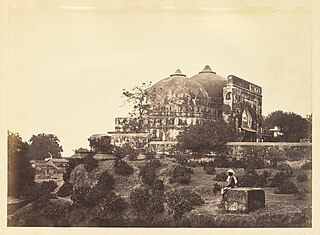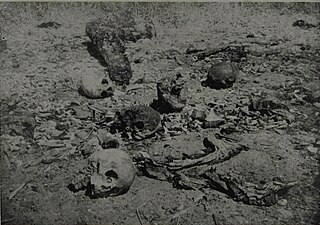
Direct Action Day was the day the All-India Muslim League decided to take "direct action" for a separate Muslim homeland after the British exit from India. Also known as the 1946 Calcutta Killings, it was a day of nationwide communal riots. It led to large-scale violence between Muslims and Hindus in the city of Calcutta in the Bengal province of British India. The day also marked the start of what is known as The Week of the Long Knives. While there is a certain degree of consensus on the magnitude of the killings, including their short-term consequences, controversy remains regarding the exact sequence of events, the various actors' responsibility and the long-term political consequences.
In the Bombay riots in December 1992 and January 1993, an estimated 900 people died. The riots were mainly due to escalations of hostilities after large scale protests by Muslims in reaction to the 1992 Babri Masjid Demolition by Hindu Karsevaks in Ayodhya; and by Hindu mobs in regards with the Ram Temple issue.

The 2002 Gujarat riots, also known as the 2002 Gujarat violence, was a three-day period of inter-communal violence in the western Indian state of Gujarat. The burning of a train in Godhra on 27 February 2002, which caused the deaths of 58 Hindu pilgrims and karsevaks returning from Ayodhya, is cited as having instigated the violence. Following the initial riot incidents, there were further outbreaks of violence in Ahmedabad for three months; statewide, there were further outbreaks of violence against the minority Muslim population of Gujarat for the next year.

On 7 November 1966, a group of Hindu protestors, led by ascetics, naga sadhus and backed by Rashtriya Swayamsevak Sangh and Bharatiya Jana Sangh, approached the Indian Parliament to protest to criminalize cow slaughter. The incident resulted in a riot which ended with a death toll of 7 people and hundreds were injured. The total damage was estimated at about 1 billion rupees by city officials; numerous vehicles were destroyed, along with numerous shops.
Religious violence in India includes acts of violence by followers of one religious group against followers and institutions of another religious group, often in the form of rioting. Religious violence in India has generally involved Hindus and Muslims.
The cow protection movement is a predominantly Indian religious and political movement aiming to protect cows, whose slaughter has been broadly opposed by Hindus, Buddhists, Jains, Zoroastrians and Sikhs. While the opposition to slaughter of animals, including cows, has extensive and ancient roots in Indian history, the term refers to modern movements dating back to colonial era British India. The earliest such activism is traceable to Namdhari (Kooka) Sikhs of Punjab who opposed cow slaughter in the 1860s. The movement became popular in the 1880s and thereafter, attracting the support from the Arya Samaj founder Swami Dayananda Saraswati in the late 19th century, and from Mahatma Gandhi in the early 20th century.

Atal Bihari Vajpayee was an Indian politician who served twice as Prime Minister of India, first from 16 May to 1 June 1996, and then from 19 March 1998 to 22 May 2004. A member of the Bharatiya Janata Party (BJP), Vajpayee was the tenth Prime Minister. He headed the BJP-led National Democratic Alliance in the Indian Parliament, and became the first Prime Minister unaffiliated with the Indian National Congress to complete a full five-year term in office. He died at the age of 93 on Thursday 16 August 2018 at 17:05 at AIIMS, New Delhi.
The 2010 Deganga riots occurred at Deganga, North 24 Parganas in West Bengal, India on 6 September 2010 between local Muslim and Hindu community over a disputed land. The violence began late in the evening of that Monday and continued throughout the night and for several subsequent days. The district police, Rapid Action Force, paramilitary were all unable to quell the problems and the Indian Army was eventually deployed. The army staged a series of flag marches on the Taki Road but the violence continued in the interior villages lying off that road until Thursday, despite the army presence and the promulgation of prohibitory orders under section 144 of the Criminal Procedure Code. Military Commanders on approval by the state Government imposed AFSPA.

The demolition of the Babri Masjid was carried out on 6 December 1992 by a large group of activists of the Vishva Hindu Parishad and allied organisations. The 16th-century Babri Masjid in the city of Ayodhya, in Uttar Pradesh, India, had been the subject of a lengthy socio-political dispute, and was targeted after a political rally organised by Hindu nationalist organisations turned violent.

The 1947 Rawalpindi massacres refer to widespread violence, massacres, and rapes of Hindus and Sikhs by Muslim mobs in the Rawalpindi Division of the Punjab Province of British India in March 1947. The violence preceded the partition of India and was instigated and perpetrated by the Muslim League National Guards—the militant wing of the Muslim League—as well as local cadres and politicians of the League, demobilised Muslim soldiers, local officials and policemen. It followed the fall of a coalition government of the Punjab Unionists, Indian National Congress and Akali Dal, achieved through a six-week campaign by the Muslim League. The riots left between 2,000 and 7,000 Sikhs and Hindus dead, and set off their mass exodus from Rawalpindi Division. 80,000 Sikhs and Hindus were estimated to have left the Division by the end of April. The incidents were the first instance of partition-related violence in Punjab to show clear manifestations of ethnic cleansing, and marked the beginning of systematic violence against women that accompanied the partition, seeing rampant sexual violence, rape, and forced conversions, with many women committing mass suicides along with their children, and many killed by their male relatives, for fear of abduction and rape. The events are sometimes referred to as the Rape of Rawalpindi.
Paul Richard Brass was an American political scientist known for his research on the politics of India. He was professor emeritus of political science and international relations at the Henry M. Jackson School of International Studies, University of Washington, where he taught since 1965. After his B.A. in government in 1958 from Harvard College, he did M.A. in political science, University of Chicago in 1959, followed by Ph.D. in political science, University of Chicago in 1964.

The Bhagalpur violence of 1989 took place between Hindus and Muslims in the Bhagalpur district of Bihar, India. The violence started on 24 October 1989, and the violent incidents continued for 2 months, affecting the Bhagalpur city and 250 villages around it. Over 1,000 people were killed, and another 50,000 were displaced as a result of the violence. It was the worst instance of Hindu-Muslim violence in independent India at the time.

The 1969 Gujarat riots involved communal violence between Hindus and Muslims during September–October 1969, in Gujarat, India. The violence was Gujarat's first major riot that involved massacre, arson, and looting on a large scale. It was the most deadly Hindu-Muslim violence since the partition of India in 1947, and remained so until the 1989 Bhagalpur violence.

The 1980 Moradabad riots, also known as the Moradabad Muslim Massacre, refers to violence that happened in the Indian city of Moradabad during August–November 1980. When a pig entered the local Idgah during the Eid festival prayer on 13 August, local Muslims asked the police to remove the pig, but the police refused to do so. This led to a confrontation between the police and the Muslims. The police responded with indiscriminate firing, which led to over one hundred deaths. This was followed by a series of violent incidents which became religious in nature, and led to arson, looting and murders.
The 1925 Indian riots refers to the sixteen communal riots which occurred throughout British India. Reported as being among the worst were in March in Delhi, during September in Aligarh, at Arvi in the Wardha district and in Solapur.
There have been several instances of religious violence against Muslims since the partition of India in 1947, frequently in the form of violent attacks on Muslims by Hindu nationalist mobs that form a pattern of sporadic sectarian violence between the Hindu and Muslim communities. Over 10,000 people have been killed in Hindu-Muslim communal violence since 1950 in 6,933 instances of communal violence between 1954 and 1982.
Cow vigilante violence is a pattern of mob-based collective vigilante violence seen in India perpetuated "by Hindu nationalists against non-Hindus in the name of protecting cows, which they consider sacred in Hindu religion".

The 2020 Delhi riots, or North East Delhi riots, were multiple waves of bloodshed, property destruction, and rioting in North East Delhi, beginning on 23 February 2020 and caused chiefly by Hindu mobs attacking Muslims. Of the 53 people killed, two-thirds were Muslims who were shot, slashed with repeated blows, or set on fire. The dead also included a policeman, an intelligence officer and over a dozen Hindus, who were shot or assaulted. More than a week after the violence had ended, hundreds of wounded were languishing in inadequately staffed medical facilities and corpses were being found in open drains. By mid-March many Muslims had remained missing.









